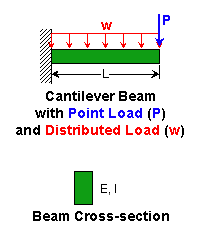Normal Stresses | Shear Stresses | Beam Deflection



| 7.2 Superposition Normal Stresses | Shear Stresses | Beam Deflection |


 |
|
» Normal Stresses
Click below to see the Normal Stress Distribution due to: 1) The Axial Force, P;2) The Moment, M; 3) The Axial Force, P and the Moment, M. |


|
|
» Shear Stresses
Click below to see the Shear Stresses at points 0, 1, 2, 3, and 4 due to: 1) The Transverse Shear Force, V;2) The Torque, T; 3) The Transverse Shear Force, V and the Torque, T. (Image at right is face of beam looking in the negative x direction) |


|
|
» Beam Deflection
Click below to see the Moment and Deflection in the Beam due to: 1) The Point Force (P);2) The Distributed Load (w); 3) The Point Force (P) and the Distributed Load (w). |
 |

|


 |